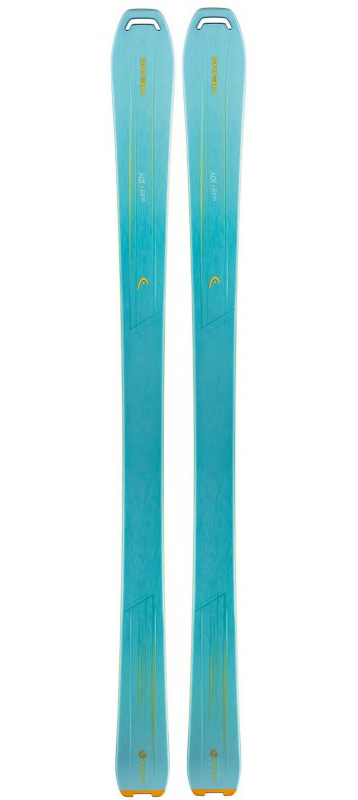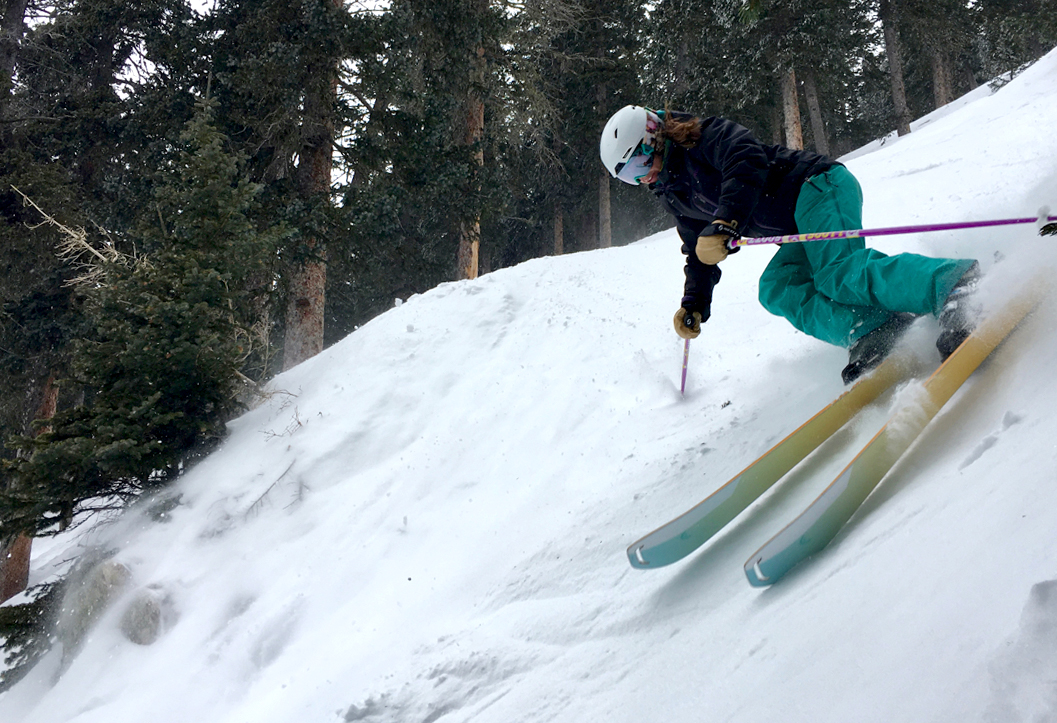
Ski: 2018-2019 Head Wild Joy, 168 cm
Available Lengths: 153, 158, 168, 173 cm
Blister’s Measured Tip-to-Tail Length: 167.1 cm
Blister’s Measured Weight per Ski: 1551 & 1604 grams
Stated Dimensions: 139-90-119 mm
Blister’s Measured Dimensions: 138-89.5-117.5 mm
Stated Sidecut Radius: 14.4 meters
Tip & Tail Splay (ski decambered): 55 mm / 15 mm
Traditional Camber Underfoot: ~5 mm
Core: Silver Fir + Koroyd Inlays + Graphene Tips/Tails + Fiberglass Laminate
Factory Recommended Mount Point: -11.15 cm from center; 72.4 cm from tail
Days Skied: ~10
Test Location: Breckenridge, CO; Taos & Ski Santa Fe, NM
[Note: Our review was conducted on the 17/18 Wild Joy, which was not changed for 18/19, apart from graphics.]
Intro
The Wild Joy is Head’s newest women’s-specific all-mountain ski, which they say is for both the “steepest slopes and the deepest powder.”
That’s certainly not the first time a company has made a similar claim, but there are a few features that make the Wild Joy fairly unique: it’s light, it has wide tips and a relatively narrow 90 mm waist, and a very stiff flex pattern. I was eager to see if the Wild Joy really could function as a true all-mountain ski, or if the stiffness and narrow width would limit it mostly to on-piste skiing.
I spent most of my time on the Wild Joy at Breckenridge, Colorado during an unusually warm spell in the middle of last season. The result was a series of freeze-thaw cycles, and plenty of variable conditions. After spending the the past five years on skis at least 100mm-underfoot, I was excited to get back on a potentially more nimble ski given the firm snow conditions.
Flex Pattern
The Wild Joy is a very stiff ski in general, and especially for a women’s-specific model. We’d sum up its flex pattern like this:
Tips: 8
Shovels: 9
Underfoot: 9
Behind the Heel piece: 9/8
Tails: 9
Groomers
With a 90mm-waist, 14.4 m sidecut, and stiff profile, I expected that groomers would be where the Wild Joy would perform best. I was also intrigued by the combination of low weight and stiffness, since I am relatively light and don’t have a lot of weight to throw into a turn, but I also tend to prefer skiing on edge at speed and therefore need a somewhat stiff ski with a good bit of stability.
My first run on the Wild Joy was on perfect corduroy. While I quite like how my much-wider all-mountain ski, the Line Pandora 110, performs on groomers, I soon remembered what a more on-piste-oriented ski can really do when it comes to hard carving.
The Wild Joy is very quick edge-to-edge, yet remains incredibly composed throughout long, deep turns where I could drive the ski at high speeds and get into the stiff flex of the ski.
Subsequently, transitioning out of a turn and into the next was smooth and dynamic (in some instances when my timing was perfect, I found myself literally popping out of one turn and into the next).
At higher speeds, the Wild Joy becomes even more responsive, but they also require you to stay really focused. They are stiff and stable at pretty high speeds, but they are also light, and that lack of weight makes the skis pretty unforgiving if you’re skiing flat out — they will allow you to go very fast, just don’t get lazy. As I noted, these skis become more responsive the faster you’re skiing, so the ski will immediately respond to your input, even if that input is sloppy. So the faster you ski, the more precise input the Wild Joy will require of you.
I did find that the Wild Joy offered a lot of versatility in terms of turn size. As mentioned above, the ski does wonders with fast wide GS turns, but also worked well while making tighter, slalom-style turns.
Moguls
My first bump run on the Wild Joy was down Crescendo at Breckenridge. This is a low-angle blue run, and the moguls were large, rounded, and hard. While the Wild Joy’s stiff tails offered a stable platform to initiate a turn, navigating bumps with the ski’s wide tips (and therefore, a necessarily wider stance), made it somewhat challenging to take a tight line through the moguls. I also prefer to ski lower-angle bumps with the bases of my skis pretty flat (making it easy to pivot through the bumps), but when doing so, I felt like the deep sidecut of the Wild Joy was fighting me in this terrain, and the shovels would want to hook up into a carved turn when I was looking to keep a straighter line down the fall line. Of course, if you prefer to carve your way through bumps rather than pivot through them, the Wild Joy will be a better match for that style of bump skiing.

In steeper moguls, the Wild Joy’s significant sidecut helped bite into the hard snow, but I still thought that the wide shovels felt cumbersome while trying to take a tight line down the moguls. I also wondered if mounting the ski forward of Head’s factory recommended line (which is set back quite far at a very traditional -11.15 cm behind true center) would help alleviate the issues with the tips.
Hard Crud / Soft Crud / Corn
The freeze-thaw cycle that Breckenridge was experiencing while I was testing the Wild Joy made for some pretty variable conditions. Previously baked snow on most south-facing aspects was bulletproof in the morning and turned to soft corn by mid afternoon.
On firm, off-piste snow, the Wild Joy likes to be on edge, and when skied aggressively with good form, the ski rewards you with plenty of stability. However, the Wild Joy’s combination of low weight + stiff flex pattern again meant that the ski was more responsive than forgiving in these conditions — I had to be pretty spot-on with my body position, timing, and turn initiation to make these skis work in hard crud.
As the snow softened up to the point of soupy slush, I found it a bit difficult to engage and bend the stiff flex of the ski, and the ride felt less playful, and I was less able to work the ski into a variety of turn shapes; the stiff flex and tighter sidecut of the Wild Joy was forcing me to roll onto my edges more than I preferred.
The Wild Joy’s wide tips were helpful in the wet and heavy snow pack, but were a bit cumbersome and felt a little awkward given the narrow width underfoot. I found that I had to pay a lot of attention to managing my tips, and again, had to force myself to ski with a wider stance than normal in order to avoid crossing the tips. Overall, I felt like the Wild Joy was too bossy — too insistent on working in one particular way — for this variable snow.
Chalky Steep Terrain
Unlike in the wet, soft chop I describe above, I had a blast on the Wild Joy on steeper, chalky terrain. I spent the majority of my time on this ski on big, steep, north-facing bowls. And as with its groomer performance, I was impressed by the stability of the Wild Joy in these chalky bowls and I found that I could ski at high speeds without any deflection or folding up at the tips. Compared to the 16/17 Nordica Santa Ana 100, I had a much easier time finishing my turns on the Wild Joy, and was therefore able to maintain control at higher speeds.
I was again surprised and delighted by how well the Wild Joy was able to transition from turn to turn even with smaller, tighter turns on steep terrain. I was worried its big shovels might make smaller turns difficult, but the low weight and rebound of the ski allowed for a quick transition from one edge to the other.
Powder
While I didn’t get the Wild Joy out in any very deep snow, I would be interested to see how this ski would do given its low weight, wide tips, and very setback mount point. I think the main things holding the Wild Joy back would be its narrow waist and potentially hooky sidecut, but in light, deep snow, those wide tips ought to plane up without problem, and in the 3-4” of new snow I did get the Wild Joy in, the skis certainly were stable.

We’ll update this review if we get the Wild Joy into heavier, wetter snow, but our hunch is that the narrower waist, tight sidecut, and lack of tail rocker is not going to fare that well in funkier, dense cement or wet pow.
Bottom Line
The HEAD Wild Joy is most in its element when carving hard on firm snow (groomers, chalk, ice), and when skiing steep, wide-open bowls. It is a powerful and precise carver that’s best suited to advanced and expert skiers that know how to work a ski from edge to edge, and spend the bulk of their time skiing either smooth, firm snow or light, dry powder.
So if that resonates with your style and that’s the sort of “all-mountain” skiing you do most, the Wild Joy could be a very good fit.
NEXT: Rocker Profile Pics
